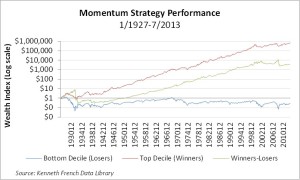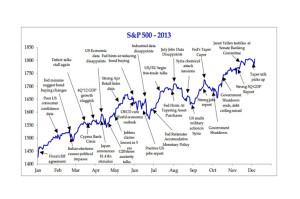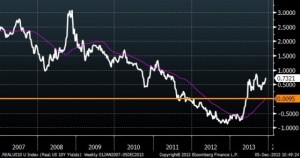For instance, the British paper The Guardian, which was involved in breaking the Snowden scandal, had this to say: “Bitcoins are an anonymous, decentralised, peer-to-peer digital currency.”
If you take Bitcoin for what it really is, it’s very easy to understand why it continues to rise in value; why the government is so seemingly willing to let it slide and even leans toward supporting it; and why its widespread adoption would ultimately lead to exactly the opposite of the libertarian utopia that many of its proponents believe it will usher in.
It all starts with Ross Ulbricht, a smart and driven University of Pennsylvania alumnus better known to his customers as Dread Pirate Roberts. Roberts, er, Ulbricht, ran the infamous Silk Road website, which dealt predominantly in the trafficking of illegal drugs around the world.
An eBay clone run on the peer-to-peer “darknet” Tor, designed to give users true anonymity on the Web, Silk Road was as far from the mainstream as a website can get. Despite the hurdles to be jumped to gain access, the site’s main products drew thousands of users, eager to take advantage of the ease of ecommerce in a traditionally back-alley kind of business.
The site used the breakaway digital currency, Bitcoin, for its transactions, since it was going to be hard to accept Visa for that kind of business.
However, early in October, the website was seized by the US government, and Ulbricht was arrested. FBI agents then proceeded to take control of the hundreds of thousands of bitcoins that Ulbricht had collected as transaction fees on Silk Road.
Those “coins” are highly likely to lead the FBI to a long list of additional people to prosecute—namely the buyers and sellers who frequented Silk Road.
Just how did the FBI—known for having the technical might of a 1987 elementary-school computer lab—manage to not only track down Ulbricht, but to seize his supposedly anonymous and highly secure digital fortune?
It didn’t call in the NSA to start cracking codes and dig through its sweeping communications logs.
The former part—finding Ulbricht—was easy. It just took some good old-fashioned detective work. Ulbricht spent much of his time in the months before launching Silk Road working on public Internet forums to understand Bitcoin and recruit helpers. Once that trail was untangled, the FBI was able find and arrest him, seizing the equipment used to run the illegal enterprise in the process.
The latter is a little more complex… but not by much. You see, thanks to the very design of the Bitcoin currency, it’s almost as vulnerable as cash held in a home safe. The safe might take sophisticated and expensive tools to crack it or it might not, depending on its quality. Similarly, with a Bitcoin “wallet”—i.e., the computer program that stores the digital coins a user has amassed and communicates with other users to send them—it can be easier or harder to get at them.
By default, a wallet is just a simple program that can be opened with a password. Give someone else that password, and that person can simply transfer the coins to him- or herself. Though there are stronger ways to secure a wallet—such as by hiding a key file on a different device and only connecting them when needed (called two-factor authentication)—it can still be compromised.
Of course, once you’ve been arrested, you can bet federal prosecutors will be hard at work trying to crack that digital safe. Stronger-quality encryption might take longer to crack—months, even years. But if they want in badly enough, they’ll get in eventually. Besides, at the same time they’ll be working on the shortcut: pressing on you to give away the combination. The threat of a long stay in federal prison usually loosens up lips on subjects like that.
Nearly as easily as cash or a bank account is grabbed, bitcoins can be too, if the authorities know where you keep them.
If you don’t encrypt the device that holds them, then they’re about as secure as cash in a wallet or a duffle bag. Once the police get their hands on it, it’s theirs. Plain and simple.
However, even if you’re encrypted and they cannot open the wallet in which you keep your bitcoins to transfer them away, so long as they control the device where the coins are stored, then you cannot spend them, either—those coins are effectively out of circulation.
This is how the FBI seized something like $10 million to $50 million in bitcoins (depending on what exchange rate you use to value them) from Ulbricht. It just took his computer, and the coins on it came along.
That’s because from the beginning, bitcoins were meant to serve a similar role to cash in a digital society. In other words, they could be exchanged from person to person without having to put a processor like Visa or American Express in the middle. This, for obvious reasons, made them attractive to those dealing in alternative products and services… the kind that remain cash businesses today.
But there’s a subtle difference between cash and bitcoins still. In order to make a digital form of cash, it needs to have some protection against being copied. In other words, I cannot just hit copy and paste and thereby turn one “coin” into two, like I can with a PDF. So each bitcoin contains a record of how it was created and when it was exchanged, which creates a digital audit trail to ensure a coin is valid.
Each individual user adds bits and bytes to the coin, passing it along with encrypted data that spells out who he got it from, where he is sending it to, and when.
It’s sort of like a transfer between two safe deposit boxes. I use my key to open my safe, hand my money to you, then you use your key to lock it safely away. However, Bitcoin must certify that what you pass along later is the actual coin I gave you. Thus, every time it changes hands, it is marked with a signature (a “hash,” in technical terms) of both the previous transaction and the future owner. This is like if every paper bill handed from me to you, across the table in the safe deposit vault, could not be exchanged without first adding a permanent, non-removable copy of both our fingerprints to each one.
That is a gross oversimplification, of course. But the system’s value lies largely in its simplicity. The original paper describing how Bitcoin works is remarkable in that regard. It outlines just how to provide a system where digital money can be used like cash, sans central intermediary, without losing trust that a coin is genuine—by making the transaction log public but anonymous.
But even the authors find fault in the method (emphasis added):
“As an additional firewall, a new key pair should be used for each transaction to keep them from being linked to a common owner. Some linking is still unavoidable with multi-input transactions, which necessarily reveal that their inputs were owned by the same owner. The risk is that if the owner of a key is revealed, linking could reveal other transactions that belonged to the same owner.”
In other words, despite the fact that a bitcoin’s embedded audit trail is anonymized and nothing more than a seemingly random set of numbers, those numbers can theoretically be traced back to a common account if coalesced from more than one recipient.
Unlike what The Guardian wrote, Bitcoin is not anonymous by default. It is pseudonymous. If you use the same pseudonym (in this case, a key pair from your Bitcoin digital wallet) in multiple locations, then all that activity can be traced back to the same place. Like a street thug with an “AKA,” it only works until you find one person who knows the alias and can say, “Yes, that guy is ‘Fat Tony’.”
Unless the user takes explicit steps when using his bitcoins to generate a new pair of keys with every transaction—something some wallets can do automatically, granted—then your activity on a site like Silk Road could theoretically be tied back to you, once the FBI pinpoints just what wallet identifiers the site’s owner used to take in and pay out the funds.
Silk Road, while trying to provide its users with anonymity from each other (and ensure it got its cut—probably far more of the motivating factor), introduced a centralized point to an otherwise decentralized system, poking yet another hole in the process.
Bitcoins themselves are both anonymous and decentralized in how they are created and exchanged, yes. But when you begin introducing online wallets, sites acting as escrow providers, and similar such intermediaries, the system loses a little of both. Then you have the equivalent of a currency where the criminals almost volunteer to start using the digital equivalent of “marked bills” from those old FBI sting movies.
Internally, Silk Road used a mathematical process called a “tumbler” to try to make sure that never happened. It rolled the encrypted codes on each coin collected through lots of accounts before sending them on to the seller, making sure the input coin could never be matched to the seller or product. That also made it hard to determine just who was depositing funds to buy illegal things, and who was innocently picking up one of the (few) legal items for sale.
The theory was: it’s not illegal to deposit money with someone like Silk Road if it cannot be traced to an illegal purchase. But that’s easily dealt with. All it would take is a zealous federal prosecutor who rebrands Silk Road as a terrorist site (a small leap given that you could buy heroin on the site, and that’s a drug often linked to Afghani groups that wear the terrorist tag, justly or not). Then all activity on the site immediately becomes illegal.
That’s not what happened. But in spite of those extra measures put into place by Silk Road, academic researchers have been able to show how transactions could be traced back to Silk Road with relative ease. Forbes presented an excellent analysis of this problem in an article published just weeks before Silk Road’s founder was nabbed by the feds.
The question, then, is whether or not the FBI used all of the computer records on the Silk Road system to start sniffing out buyers, or (more likely, since the buyers have no good information to snitch with in an anonymous marketplace) focused on sellers who transacted on Bitcoin. Even if they don’t show up on particular doorsteps this time around, you can be pretty sure they’ve already used those records to build a list of whom to keep close tabs on.
If receiving large payments from Silk Road isn’t probable cause enough for a wiretapping warrant, I don’t know what is.
Which is probably a large part of why Congress is holding hearings on Bitcoin, and Ben Bernanke gave it a nod of the beard in light support.
It’s not easy to trace or monitor bitcoins. And a careful user can definitely stay close to anonymous within the system—using a combination of an Internet anonymizer, new key pairs with every transaction, and a bit of tumbling to prevent patterns, for example.
But bitcoins are much more susceptible to tracking than either cash or gold, the current off-the-radar transaction tools most used to evade authorities.
The use of bitcoins, especially by most users—who tend to choose the very popular online wallet services that store your account info in a nice, easy-to-access, easy-to-subpoena, online vault—is exactly the kind of traceable activity that investigators froth over.
So from the perspective of law enforcement, there’s enormous benefit—even from a marginal improvement—in allowing Bitcoin to prosper. It just doesn’t make sense to shut it down quite yet, and may not ever.
Plus, why close down what you can tax?
How long, for instance, do you think it’ll be before Congress starts demanding that exchange and online wallet providers submit tax statements to the IRS?
Maybe they want a piece of the gains made when you bought some bitcoins at the start of this year, then sold them as the price went parabolic under the demand driven by C-SPAN’s telecast of Washington’s recent hearings on the subject:
Of course, that the price went so high with such low volume underscores why maybe, just maybe, Bitcoin will be here to stay.
The currency is finite. Only so many bitcoins can be “mined” from the digital ether, and each is harder to extract than the previous one. When the government seized Ulbricht’s accounts, by some accounts it eliminated as much as 3-5% of the total bitcoins in existence (about 12 million today), thus initiating a supply crunch which would send any commodity upward a bit.
Whether the government can crack Ulbricht’s encryptions and lay its hands on his actual coins remains unknown, but since it has his computer, they are effectively withdrawn from circulation no matter what. And how it intends to process such an unusual asset seizure is another intriguing question.
Add the current notoriety to the supply shortfall, and demand for the coins has predictably risen (albeit far more than anyone expected), largely among a group new to the asset. Those already holding it weren’t off selling while the price was still rising, like they did last April during those big red spikes on the volume indicator. Instead, as during the housing bubble before it, and the dot-com bubble before that, the paper gains that result from outsized demand and tight supply are pushing the currency ever upward in a self-reinforcing trend.
Each $100 the price rises is another 467 news stories in USA Today, Forbes, the Economist, and here at Casey Research of course, as I obviously gave in to the temptation to write. All that publicity helps create another pile of investors looking to buy the 20K to 50K coins that exchange for fiat currencies each day on the largest outlet, the Mt. Gox exchange.
Even when not getting bubblicious, as they are today, bitcoins will naturally rise in price so long as they are readily convertible to other forms of money. If that ever ends, through government intervention or for some other reason, they will quickly go to zero.
For now though, Bitcoin is flourishing. And thanks to exchanges like Mt. Gox and sites like Gyft that allow you to spend bitcoins on dollar-denominated gift cards, using bitcoins to freely move digital money between persons will likely remain in demand for some time to come. It’s especially advantageous across borders and along other avenues where it might be difficult or impossible to make such transfers without raising eyebrows, finding oneself in a room with an interrogator, or being blocked altogether.
Check out the following links for more information on developments related to Bitcoins:
China Bans Financial Companies From Bitcoin Transactions
Greenspan Says Bitcoin a Bubble Without Intrinsic Currency Value
Bitcoin Market Gets a Lift From China
Bankers Balking at Bitcoin in U.S. as Real-World Obstacles Mount
Bitcoin: its future as a platform and protocol
http://versiononeventures.com/bitcoin-observations-thoughts/
Prices of Different Digital Currencies
http://coinmarketcap.com/
How Much Does that Burger Cost in Bitcoins?
https://www.mtgox.com/
Bitcoin drops 50 overnight as chinas biggest btc exchange stops deposits in chinese yuan
Bitcoin Tops $1,000 Again as Zynga Accepts Virtual Money
Bitcoin’s Future Foretold By Developer Momentum
Beware Bitcoin: US Brokerage Regulator







